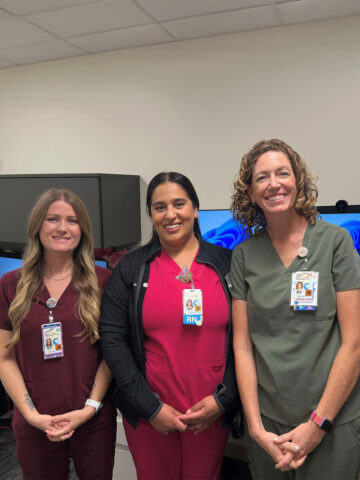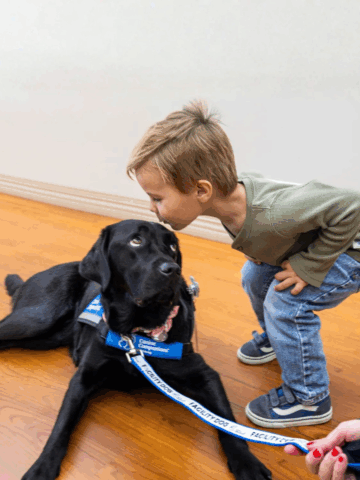The CHOC Mental Health Inpatient Center is an inpatient psychiatric center exclusively dedicated to the treatment of children ages 3-17 with mental illness who are in immediate risk of hurting themselves or others. It is the only inpatient facility in Orange County that can treat patients younger than 12. Our doctors and care team are all specially trained to treat children and provide the very best patient- and family-centered care 24 hours a day, seven days a week.
During a child’s stay, he or she engages in daily multidisciplinary therapeutic groups and receives individual therapy, family therapy, brief psychological testing and psychiatric care.
In observance of Mental Health Month, follow along for a day in the life of Madeline, a clinical nurse in CHOC’s Mental Health Inpatient Center.
5:15 a.m. – After fighting my snooze button, I wake up, shower, and drink some much-needed coffee.
6:30 a.m. – My cat yells his goodbyes to me as I give him a treat and leave for work. On the way, I vibe out to music to get pumped up for the day. I’ve worked at CHOC for over a year now. Last year, I was accepted into CHOC’s Registered Nurse Residency program. As a new nurse, I felt called to work in a mental health setting. I am beyond proud to stand alongside the brilliant CHOC team on the frontlines of mental healthcare.
7:00 a.m. – I join my team in our conference room for a daily briefing report. Together, we review any newly admitted patients, our current population of patients, and any safety concerns. One of the ways we keep kids safe is through trauma-informed care. Upon admission, we work with patients and their families to determine any triggering situations or actions the patients may have, and then learn how strong emotions may manifest outwardly; such as pacing, shaking, or becoming very quiet. This information helps us to rapidly identify when patients are struggling and may need extra support or encouragement to utilize their coping skills. One of my favorite environmental adaptations we can provide for patients is our sensory room. It helps stimulate a few of our five senses to help kids cope and be more present in the moment. Sometimes, just hearing the rhythmic movements of the bubbles can be soothing and have a great calming effect.
7:30 a.m. – Once I have an understanding of our environment, I walk the unit to check on the patients. Most are still asleep, so I then look up my patient’s medications, while verifying medication consents. All pediatric psychiatric medications need parental consent obtained by the patient’s psychiatrist.
8:15 a.m. — Our medication room has a barn door, so I can efficiently and safely administer patients’ morning medications, preform a quick mental status check-in, and obtain vitals.
9:30 a.m. — One of my patients is currently taking a new medication. In order to better understand her body’s acceptance and tolerance of the drug, we need to run labs. Before drawing her blood, I numb a small area of her skin using a J-Tip®. During the blood draw, a child life specialist and I help the patient cope by offering her modeling clay and a hide-and-seek activity book.
10:00 a.m. — Throughout the day, our patients are divided into groups based on age to attend group sessions. This creates a structured environment that promotes the development of coping and social skills they can utilize when they go home. The sessions focus on our various themes of the day that can range from problem solving or emotional regulation to nutrition and wellness. These sessions are led by our team of nurses, social workers, child life specialists, plus and art and music therapists. This morning’s group session is focused on gross motor skills. Our group leaders soak up some sunshine in our beautiful outdoor area while supervising patients socializing and joining in on a game of handball.
11:00 a.m. — I sit down with one of my patients to discuss their day so far and check in on any thoughts of self-harm that we can work through together. Afterwards, as part of the patient care team, I meet with that patient’s psychiatrist Dr. Lavanya Wusirika, and social worker Gaby, to discuss the patient’s care plan.
12:30 p.m. – It’s time for the patients to have lunch. Our patients eat together, so I assist with passing out lunch trays and pouring drinks. One of our licensed vocational nurses, Brenda, has become our unofficial DJ, and she plays music during lunch to help create a fun, therapeutic environment.
1:00 p.m. – I receive a call from a patient’s parent. After addressing their questions, I update them on their child’s plan of care, medications and current temperament.
2:00 p.m. – I use my own lunch break to catch up with my coworkers. We spend a lot of time together, and I’m lucky to have such an amazing work family.
3:00 p.m. – It’s time for one of our patients to head home. Upon admission to the unit, our team begins organizing outside resources and planning ways to increase safety and support at home. This information is built upon throughout their stay and is incorporated into an individualized safety and coping plan. After our social workers discuss the plan for home with the patient and their parent, I review current medication information and additional discharge instructions. Staff members and fellow patients send off their peer with warm wishes and words of encouragement.
4:30 p.m. –As a nurse, it’s my turn to lead one of our nursing groups. After the patients participate in a discussion about favorite coping skills and we do a check-in of their current emotions, we follow a painting tutorial to practice our theme of the day, mindfulness.
6:00 p.m. – I spend time updating my patients’ charts, including their mental status assessments and treatment plans. This way our whole team can see the patient’s progress and any concerns.
6:45 p.m. – During daily community meetings, all of our patients join together, and our staff leads a check-in to summarize what has been learned from our theme of the day. Patients take turns sharing their high and low of the day and how we can build on these experiences for tomorrow.
7:00 p.m. – As our night shift nurses arrive, we take turns giving a report of their patient’s day and mental status. We share new triggers that we have learned from the patients as well as new coping skills that were helpful. Knowing how we can best care for patients before, during and after a crisis or stressful situation is fundamental for trauma-informed care. By caring for every patient as a whole, not as a diagnosis or as someone defined by their trauma or maladaptive behaviors, we are able to better understand and care for them.
8:00 p.m. ― Get home and share a delicious meal with my husband. A long hug and many kisses are bestowed unto my cat Boots. The three of us will cuddle up and watch a show before we head to sleep and start again.




